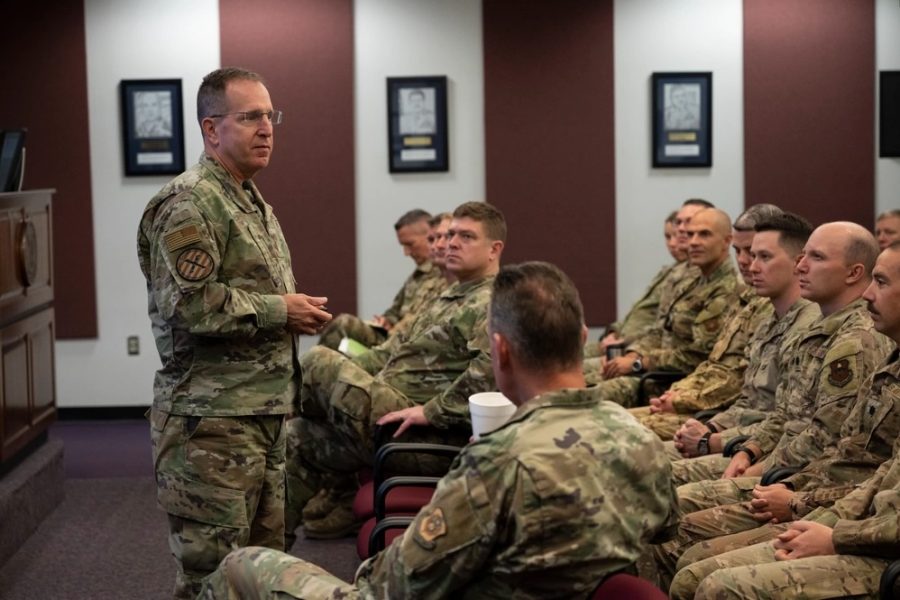Privatizing junior enlisted dormitories, guest lodging, dining facilities, and other services could take the pressure off of aging infrastructure at many Air Force bases, which has suffered from years of underfunding, Vice Chief of Staff Gen. James C. “Jim” Slife said.
“I think there’s opportunity here for public-private partnership and, frankly, business opportunities for local businesses to partner with us on privatizing noncore portions of our mission,” Slife said at the Association of Defense Communities National Summit on April 10.
Slife’s comments came a day after Rep. Don Bacon (R-Neb.), chairman of the House Armed Services Committee’s quality of life panel, lamented ongoing underinvestment in military barracks, which the Air Force calls dormitories. That lack of funding has contributed to widespread problems such as broken safety systems, mold or mildew growth, pests, broken heating or air-conditioning, and poor water quality. The military had underfunded dorms for a decade, but Congress was under the impression they were fully funded, Bacon said.
“It’s not right, we should know exactly what we’re underfunding and make those decisions together,” the retired Air Force brigadier general said at the summit. “If I had any of those dorms, I would have been fired.”
Still, Bacon acknowledged that there is not much money left over for dormitories, pay, housing allowances, and other quality of life issues as the military tries to modernize with new submarines, stealth bombers, and other technologies meant to sustain an edge over China, especially with a defense budget that makes up a near all-time low percentage of the U.S. gross domestic product, he said.
“We’re constrained, because 70 percent of our spending is mandatory and 30 percent is discretionary,” he said. “The military is going to have a hard time doing what we need to do, because of all the fiscal pressures we have right now.”
The Air Force plans on investing $1.1 billion to restore and modernize its dorms, but officials say privatization could help ease the pressure. The most senior enlisted members of the Army, Navy, and Air Force told Congress last month that they were eager to try privatizing barracks at bases where housing is either too sparse or too expensive. But lawmakers were skeptical, citing how military families have suffered unsafe private housing and unaccountable contractors for years.
“I would envision us having, in the not too distant future, hearings like we had with family housing companies,” Rep. Deborah Wasserman Schultz (D-Fla.) said at the March 20 hearing, “because the privatization process is a failure in terms of maintaining the quality of life of housing.”
The senior enlisted leaders said they learned lessons from the privatized family housing experience—namely enforcing stronger oversight on contractors. They also looked to the Navy’s Public Private Venture program, which bills itself as “resort-style” housing for single enlisted Sailors in San Diego, as a positive example to follow.
“We’re paying close attention to the Navy and the lessons that they’ve learned so that we don’t replicate some of the mistakes that came through our initial contracts that we wrote with privatizing military family housing,” Chief Master Sergeant of the Air Force David Flosi said at the hearing.
Slife took a similar tone at the Association of Defense Communities summit.
“We’ve learned some valuable lessons, some good, some not so good, about privatized housing,” he said.
The VCSAF said the Air Force is looking into granting easements right over the fence line from a military base, where contractors can build “what amounts to an apartment complex” for young Airmen. He proposed a similar model for guest lodging, food, and other services that “are not the point of the Air Force.”
“Looking for innovative ways that we can do public-private partnerships on the installations that we have might help us recapitalize some of this aging infrastructure,” Slife said.
The need is great, because many of the recapitalization timelines for that infrastructure “are nowhere near where they ought to be.”
“One of my colleagues used to say that the most expensive medical care is hospice care,” he said. “There are elements of our base infrastructure that are essentially on hospice care, and it’s pretty expensive to maintain those things.”
The Homefront
Beyond privatizing dorms and DFACs, Slife said he believes there are other areas for new kinds of partnerships between Air Force bases, local communities, and companies. In the past, he said, the relationship between bases and their civilian neighbors used to revolve around only civil issues such as schools, housing, and spouse employment. But new threats such as cybersecurity and small drones allow state and non-state enemies to harm water, power, gas, and communications infrastructure that affects both service members and civilians.
“The homeland is no longer a sanctuary,” Slife said. “As we think about reoptimizing the Air Force, how do we harden our homeland infrastructure? How do we build more resilient bases? And much of that, frankly, depends on the relationships that we have at a very local level from base to base.”
The framework used to be that issues on base were handled by Air Force law enforcement, while issues off base were handled by local law enforcement, he added. But small drones complicate that framework. Airmen can’t just leave the base and shoot down every quadcopter that looks like it might spy on the installation, he said. It requires working with law enforcement in new ways that have not been done before.
“These are nonstandard things that I’m asking for,” he said. “There is a warfighting aspect to our bases as power projection platforms that I think we have to come to grips with on a very local level.”
